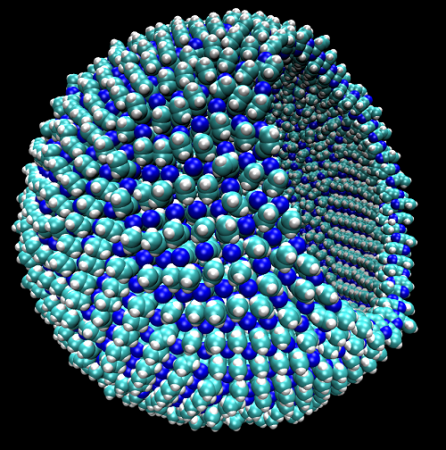
A group of researchers from Cornell University has proposed a methane-based life form that could reproduce and metabolize in similar fashion to that seen on Earth. Consisting of chemical engineers and astronomers, the team devised a template for “methane-based, oxygen-free cells” that could endure Titan’s inhospitable climate.
Saturn’s moon, Titan, possesses three enormous oceans of liquid methane and ethane. According to observations collected by the Cassini-Huygens space probe, the largest of these regions, called Kraken Mare, stretches over 150,000 square miles across Titan’s north pole.
According to the research team’s paper, which was published in the Feb. 27 issue of the journal Science Advances, the theoretical life form they presented would have a cell membrane capable of withstanding temperatures of 292 degrees below zero.

Study co-author Jonathan Lunine, who previously worked on the Cassini-Huygens mission, said he was interested in exploring what life might, potentially, be like on Titan. In doing so, Lunine enlisted the assistance of chemical engineering graduate James Stevenson.
Chemical molecular dynamics specialist Paulette Clancy said the team didn’t begin the project with any preconceptions. Looking at the likely constituents of the cell membrane, the group started out by gathering all of the known compounds on Titan. “We just worked with the compounds that we knew were there and asked, ‘if this was your palette, what can you make out of that?'”
Organic life on Earth is made up of cells that have phospholipid bilayers. These water-permeable cell membranes house all of the cellular machinery, with the bilayers also proving useful in compartmentalizing the various aspects of cell function.
In scouring the universe for extraterrestrial life, many astronomers look towards areas around stars, called habitable zones, where liquid water can persist. However, Lunine and colleagues elected to look at the possibility that cellular structure and function on Titan is based upon methane, as opposed to water.
The group called their proposed cell membrane an “azotosome.” The researchers speculate that this membrane would be made up of molecules of carbon, hydrogen and nitrogen, all of which are already present within Titan’s environment.
The chemical engineers used a series of screening technologies to identify candidates that would yield a cell membrane with sufficient flexibility, rigidity and stability, relative to the life form’s harsh climate. The researchers maintain that the most effective template for a cell membrane would comprise of acrylonitrile - an organic compound found in Titan’s atmosphere.
Looking ahead to the future, the team aims to model the behavior of such cells in Titan’s methane oceans, including the possible reproductive and metabolic capabilities of these acrylonitrile-based cells.
In a recent press release, Lunine said he was excited by the prospect of, one day, dispatching a probe to float along Titan’s expansive, methane oceans. NASA has also revealed prototype designs of a submersible device that it hopes could be used for exploration of Saturn’s moon.
